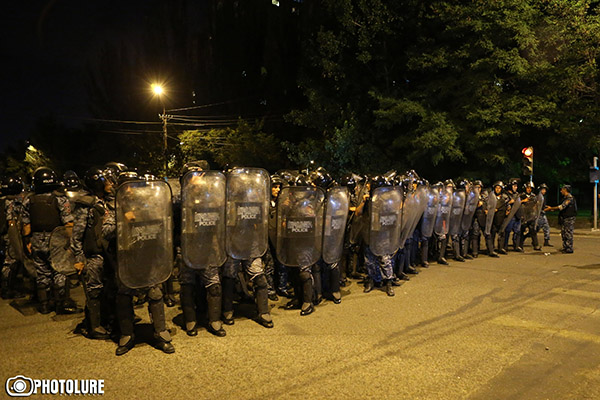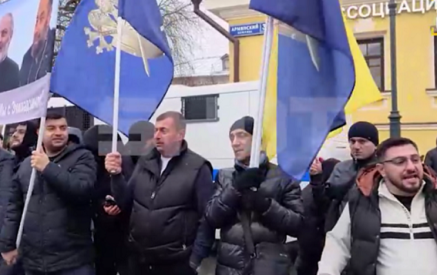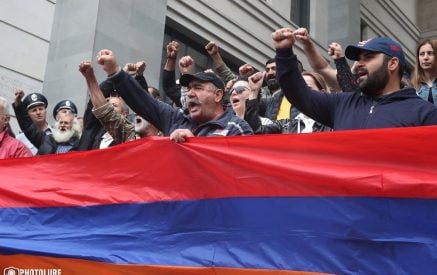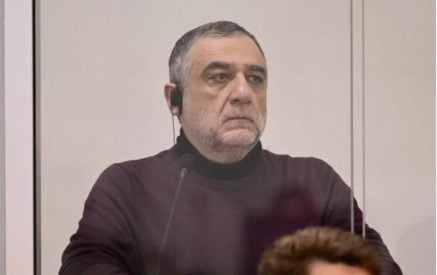(Yerevan) – Armenian police used excessive force against peaceful protesters on July 29, 2016 and assaulted journalists reporting on the demonstrations, Human Rights Watch said today. Police used stun grenades, which wounded dozens of demonstrators and some journalists, some severely. The police also beat journalists and protesters and detained dozens of people.
Armenian authorities have opened an investigation into police actions on July 29.
“Armenia’s investigation of the police assaults on demonstrators on July 29 should be swift and thorough,” said Giorgi Gogia, South Caucasus director at Human Rights Watch. “While the police have an obligation to maintain public order, they do not have carte blanche to use violence against people gathered to peacefully express their views.”
Protests have been ongoing in Armenia since July 17, when armed men from a radical opposition group seized a police station in Yerevan’s Erebuni district, killing one policeman and taking several hostages, demanding political concessions from the government. Before the gunmen surrendered on July 31, public support for them grew into a wide protest movement in Yerevan.
Read also
While police and protesters have scuffled several times, on the night of July 29 police used excessive and disproportionate force to disperse a peaceful crowd. Other protests took place without incident or police interference.
Human Rights Watch spoke with victims and witnesses of the violence. Several said that at about 11 p.m., police rapidly fired numerous rocket-projected stun grenades and threw hand-held stun grenades into the peaceful crowds near the police station in the Erebuni district. When the grenades landed, they emitted thick smoke and a loud sound, stunning many people for several seconds. The grenades then exploded, causing first- and second-degree burns and fragmentation wounds on the legs of people standing nearby.
Human Rights Watch interviewed several injured journalists and protesters in a Yerevan hospital. “Suren,” 25, whose name was changed for his protection, had just joined the protest when a stun grenade landed at his feet. He was briefly blinded by thick smoke and felt severe pain in his head. As he struggled to flee, he saw that his pant legs were almost entirely burned and his legs were covered in blood. Suren has 30 lacerations and first- and second-degree burns covering both legs. Doctors removed five plastic fragments from the stun grenade from his legs. He was not able to walk normally at the time of the interview.
One doctor Human Rights Watch interviewed said he treated a young man whose eye had been hit by stun grenade fragments. The eye had to be removed. The doctor also reported seeing 20 to 25 victims with burns and fragmentation wounds, apparently caused by the stun grenades.
Journalists and protesters said that although police told protest leaders that the crowd had to disperse, the police did not make any meaningful effort to warn the crowds to disperse or about their plans to use force. Police did not use other means of crowd control before resorting to stun grenades.
In a statement on July 30, the Armenian police alleged that protesters attempted to break through a police cordon established to keep people away from the police station and that the police actions were necessary. According to the authorities, they have opened an investigation into the organization of and participation in mass public disorder, and have arrested 23 people.
Interviewees told Human Rights Watch that the crowd was not attempting to cross the cordon when police started launching the stun grenades. Video footage of the events reviewed by Human Rights Watch supports the witness accounts.
While police could legitimately seek to prevent protesters from getting too close to the police station, they were still bound to uphold human rights and respect standards on the use of force, Human Rights Watch said.
Security forces should not fire stun grenades directly into crowds. Although the grenades are technically non-lethal, their fragmentation can foreseeably cause serious injuries in an indiscriminate manner, exposing non-violent protesters and on-lookers to grave harm. Polystyrene in some stun grenades will melt in the heat created when they are discharged, and cause serious burn wounds. Human Rights Watch documented that many protesters had first- and second-degree burns.
Police had told several journalists to move away from the main crowd, claiming it was necessary for their safety. Most journalists complied, but were still injured by the exploding stun grenades. Journalists said police fired several stun grenades in their direction. Video footage supports these accounts.
Immediately after firing and throwing the stun grenades into the crowd, uniformed police and unidentified people in civilian clothes acting with them, ran toward the protesters, detaining many.
Police and the unidentified men also punched, kicked, and used wooden clubs to beat some journalists and protesters, and damaged or seized journalists’ equipment. Marut Vanyan, a cameraman for the Lragir.am news site, told Human Rights Watch that two unidentified men grabbed him by the arms and dragged him behind the police line, swearing at him and shouting, “What were you filming?” A group of eight to ten unidentified men then beat Vanyan with wooden clubs in the arms, back, and leg and kicked him in the stomach as he tried to protect his head with his backpack.
Vanyan showed the attackers his press badge and repeatedly told them that he is a journalist, but they did not respond. He has not seen his video camera or other equipment since the attack. Vanyan had been covering the protests since they began on July 17 without incident. “I had filmed a lot of police actions before,” he said. “I had the sense that night it would be the same: that because we are journalists we would be protected. But that night [July 29] felt like a deliberate attack on journalists.”
“Police should not interfere with the legitimate work of journalists, let alone attack and punish them for doing their jobs,” Gogia said.
Governments are obligated to respect basic human rights standards on the use of force in police operations, including in dispersing both legal and illegal demonstrations. The UN Basic Principles on the Use of Force and Firearms by Law Enforcement Officials require police to use nonviolent means, such as demands to vacate an area, before resorting to force and firearms. Police should adhere to a principle of measured escalation of force. When using force, law enforcement officials shall exercise restraint and act proportionately to the threat posed, and seek to minimize damage and injury.
The European Court of Human Rights has also found that governments should show a high tolerance for peaceful assembly, even assemblies that the authorities deem unsanctioned or illegal.
Physical assaults, including punching, kicking, or using wooden truncheons on unarmed demonstrators and journalists are never a legitimate use of force and violate the prohibition against torture and inhuman treatment.
Armenia’s Special Investigative Service opened an investigation into police actions on the night of July 29. Police also announced an internal investigation.
The authorities should ensure any investigation is thorough and effective and leads to holding accountable those responsible for the police violence, including those who gave the orders, Human Rights Watch said. The authorities should provide a full account of all munitions fired and the role of the men in civilian clothing acting with police. The authorities should also fully review all laws, regulations, and guidelines on the use of force and response by law enforcement to public order concerns, to ensure that the framework and relevant training comply with human rights standards. Law enforcement officers should always wear clear identification while on duty, as this is essential to accountability.
“If protests in Yerevan continue, police should not use excessive force against peaceful demonstrations,” Gogia said. “Violence against peaceful protestors and journalists is never justified.”
For detailed accounts, please see below.
Human Rights Watch conducted interviews in Yerevan, from July 30 to August 1, with victims and witnesses of the police actions on July 29, including eight people injured by police actions, six of them journalists. Several reported seeing other injured people on the street, in nearby houses, in an ambulance, and at the hospital.
Human Rights Watch also interviewed five residents of the Sari Tagh neighborhood, where the police violently dispersed the protesters, who witnessed the events, a doctor who treated victims in the hospital, one protest leader, and five lawyers of detained protest leaders. A Human Rights Watch researcher visited the site of the violent dispersal in Sari Tagh and examined remnants of stun grenades there. Human Rights Watch also examined video and photos of the events of July 29, and reviewed official statements. Human Rights Watch has yet to meet with authorities to discuss the violence of July 29 and share the findings.
Lead-up to Police Violence
Several hundred demonstrators gathered in two locations in the Erebuni district of Yerevan at about 10 p.m. on July 29. Many had gathered earlier at Freedom Square in central Yerevan and marched to the Erebuni district, approximately three kilometers away. Both protest sites were in the same neighborhood as the police station captured by the armed group on July 17. One group of protesters gathered in the Sari Tagh neighborhood, which is on a hill above the police station and has numerous small, narrow, winding streets. Another group gathered on Khorenatsi Street, approaching the entrance to the police station, and the site of several other protests since July 17.
On the night of July 29, riot police in riot gear and helmets, with shields and truncheons, formed cordons in both protest areas. Other uniformed police as well as unidentified men in civilian clothing, many in black shirts and black pants, acting in close cooperation with the police, were in both locations. Some police officers and men in civilian clothing wore masks.
Police Violence Against Protestors, Journalists in Sari Tagh
As the crowd gathered in Sari Tagh, protest leaders attempted to negotiate for approximately 20 minutes with police officials to allow the protesters to remain there. Police refused, telling protest leaders that the group had five minutes to disperse. Police suggested that people gather at another location, such as Liberty Square.
As during previous protests, journalists, including cameramen, many of whom were live streaming, stood between the police cordon and protesters. Journalists reported that an unidentified person in civilian clothing, apparently working with police, warned them at approximately 11 p.m. to move aside to a more secure location, to be clear of police actions against protesters. Most complied.
Police then forcibly detained a protest leader, Armen Martirosyan of the opposition Heritage political party, and began firing stun grenades into the crowd and in the direction of the journalists. Protesters and journalists began to flee. Victims and witnesses described the scene as chaotic, with people panicking and struggling to see and hear as a result of the stun grenades. Widely available video footage corroborates these statements.
Many protestors and journalists had leg injuries from the exploding stun grenades, including from grenade fragments and first- and second-degree burns.
One doctor at a Yerevan hospital said that hospital officials called him in on his day off to help treat the injured. He said the hospital treated 20 to 25 people with injuries, all of whom had burns and other lacerations on their legs. He said he saw wounds a few centimeters deep caused by plastic fragments. He said that the largest fragment removed at the hospital was three centimeters long.
Human Rights Watch examined remnants of two types of the stun grenades; one appeared to be made of a hardened polystyrene painted gray. When the bodies of stun grenades are made from this material, the polystyrene can melt in the heat created when they are discharged, and cause serious burn wounds.
Attacks on Journalists, Protesters
Police and unidentified men in civilian clothes detained protesters, beating some, and also beat journalists and damaged or took their equipment. Victims reported assaults that included dragging, punching, kicking, and beatings with wooden clubs. Victims were variously injured in their faces, arms, hands, shoulders, backs, and legs.
Robert Ananyan, A1+ Journalist
Ananyan, from A1+ information agency, said he reported and did live streaming from the Sari Tagh demonstration. He said a police cordon blocked the road. He saw high-ranking police officers telling the protest leaders to disperse within five minutes, but without making any public announcement. About 15 minutes later, police told journalists to step aside as something was about to happen: “This was the only warning we got, and within two minutes, stun grenades started exploding. There were so many of them that you could not escape.” Ananyan had multiple injuries, including stun grenade fragment wounds on both of his legs, and multiple bruises on both hands.
A local resident drove Ananyan, who was bleeding, to a hospital. Two other journalists, including a cameraman from another news outlet with fragmentation wounds on his legs, and another local resident, were also in the car. After about 800 meters, police stopped the car and forced the journalists out, detaining the driver and the resident, and taking them away. Ananyan and the cameraman found other journalists and called an ambulance, which took them to a hospital.
When Human Rights Watch visited Ananyan in the hospital, he was unable to walk due to the leg injuries.
David Harutyunyan, 1in.am Cameraman
Harutyunyan, cameraman for an online news agency, was working with a reporter for the site, Mariam Grikorian, in Sari Tagh on July 29. He also remembered police warning journalists to step aside because something was about to happen. He then heard explosions of stun grenades:
Police started beating batons on their shields and moved forward on demonstrators; also throwing stun grenades. They would take the safety pin out and throw the grenade right away toward the protesters. The grenades caused shrapnel and that’s how I got wounded. I was still filming as the attack started, but was able to move for only few meters when shrapnel hit me on my right leg.
Harutyunyan continued to film, but several men in civilian clothes started beating him with wooden clubs, breaking his camera, chasing him, and continuing to assault him:
As I was filming the dispersal, men in civilian clothes started to beat me, first breaking my camera by hitting it with a wooden club, and then beating me. I don’t know who they were. I tried to run away, but they followed me. I ran toward other journalists, but the men caught up, they pulled my PRESS badge and my bag with camera batteries. One of them tried to hit me on my head with the club, but I covered [my head] with my hand and got hit there instead. Then I bent down to cover my head and they continued to hit me on the back.
Harutyunyan managed to escape and found shelter in a local resident’s house. An ambulance later took him to the hospital. He had multiple bruises on his back, side, limbs, and hands.
Mariam Grikorian, 1in.am journalist
Grikorian was interviewed separately from Harutyunyan. She said that like other journalists, they followed the protesters from Liberty Square to the Erebuni district, providing live coverage. Grikorian also noted heavy presence of unidentified men in civilian clothes at the site, describing them as athletic men, wearing black shirts and pants, one of whom warned the journalists to step aside as something was about to happen. She said that police started the operation following the detention of Martirosyan, one of the protest leaders:
They [police] started throwing stun grenades at the public before they moved on the crowd…. Soon they threw them toward the area where the journalists were gathered. One of the grenades exploded in front of me. I could not see or hear anything; I thought I was dead. Then I realized that I could move my hands and only had difficulty moving my leg, and I realized that I was alive.
She had fragmentation wounds on the upper left thigh and right ankle. She lost sight of Harutyunyan as she ran and found shelter in a local resident’s house. Inside, she saw several other people who were bleeding, apparently also from fragmentation wounds. Grikorian was later hospitalized for several hours, as doctors extracted one plastic fragment and bandaged her ankle.
Grikorian said that as she was leaving the protest site, she saw a young man, his face covered in blood, lying on the ground. She tried to help him run, but the man said he was in too much pain and could not get up. In the hospital, Grikorian also spoke with a young woman who said she had been at the protest and who had burns on both legs, her hands and her back.
Anushavan Shahnazaryan, freelance journalist
Shahnazaryan also went to Sari Tagh on July 29 and was filming near other journalists when a man in civilian clothes, who appeared to be cooperating with police, spoke to him and other journalists. Shahnazaryan explained what happened next:
We all [journalists] moved to the side. And what I saw then from police was a kind of aggressiveness and swearing that I hadn’t seen at any other protests. The police started to launch [stun] grenades. Three or four landed where we were standing, where all the journalists were together. Seven of us [journalists and cameramen] ran and hid in some bushes. […]
We saw that one cameraman…had fragments in his legs, so we took him to the nearest house and tried to help him and get him to a hospital. …I was also injured. I was burned and had cuts on my arm from the stun grenade explosion. I went to the hospital because my ear was hurting. It’s better now. I also had very bad swelling in the left side of my face, along the jaw.
From the balcony of the house where we went I could see how men in civilian clothes, wearing all black, grabbed people who were hiding in the alleys and passageways in the neighborhood. They hid as they fled. The men beat at least 10 of them and then threw them in police cars, and drove behind the police cordon.
Armenian and international media also reported on beatings of other journalists and protesters on July 29, including three journalists from Radio Free Europe/Radio Liberty Armenian Service.
Police Violence on Khorenatsi Street
Marat Yavromyan, Yerevan State University Lecturer
Human Rights Watch interviewed Yavromyan, 37, who was detained at a parallel protest at Khorenatsi Street, a few blocks from the main protest site, and reviewed video footage from the same event. Yavromyan went to Khorenatsi Street with his 15-year-old daughter. When he arrived, there were only few people, but the crowd grew to several hundred by 10 p.m. He said there was a heavy police presence at the site, and that as people were gathering, police announced over a loudspeaker that this was an unsanctioned demonstration and that everyone should disperse within 15 minutes. Police gave another warning few minutes later.
Yavromyan said that he could not hear the announcement well, and moved closer to the police cordon to understand what they were saying, but police moved on the crowd right after the second announcement. He said that police first fired four or five munitions that lit up in the air, and then started to attack demonstrators, roughing up and detaining some of them.
He said that he could not run fast, as it was dark, and he feared for his daughter’s safety. Instead they waited on a street corner and planned to go home. However, several policemen approached them:
When I saw them charging toward me, I put my hands up in from of me, saying we see you, we are going to leave. I have my daughter with me, stay away. Don’t touch us. But they started to detain me, dragging me away, holding my feet and hands with me facing down. I shouted and cursed, telling them to let me go, but they started to kick me from below. Several of them were beating me, cursing me, broke my nose, and threw me into a police vehicle.
Police took Yavromyan to the Nor-Nork police station, where they also took about 25 other detainees. He asked police to call an ambulance, as he knew his nose was broken. About an hour and a half later an ambulance came, and medical personnel insisted on taking him to a hospital. Police refused to let him leave without signing three unspecified documents. Though he hadn’t read the documents, Yavromyan felt compelled to sign so he could get needed medical assistance.
He was taken to a hospital around 2 a.m. on July 30, where he was treated for a broken nose and received multiple stiches inside his left cheek and the side of his mouth.
Police did not detain Yavromyan’s daughter, who tried to come to her father’s aid. Police pushed her away and carried Yavromyan off. A passer-by helped the daughter make her way home.
Human Rights Watch























































